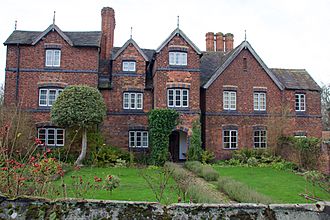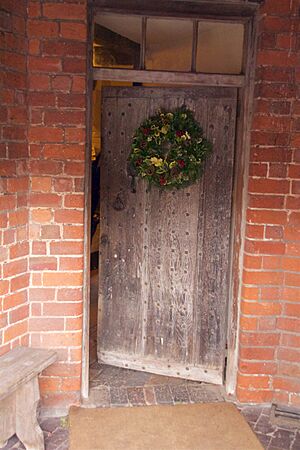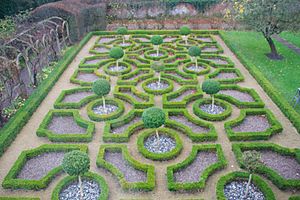Moseley Old Hall facts for kids
Quick facts for kids Moseley Old Hall |
|
|---|---|
 |
|
| General information | |
| Coordinates | 52°38′15″N 2°06′09″W / 52.6374°N 2.1024°W |
Moseley Old Hall is a very old house in Fordhouses, near Wolverhampton in the United Kingdom. It is famous because King Charles II hid there in 1651. This happened during his escape to France after he lost a big battle. Today, the National Trust looks after the hall, and it is a special Grade II* listed building.
Contents
The Historic Hall
Moseley Old Hall is located in Staffordshire, a county in England.
Building the Hall
A family called Cordsall owned the land where the hall stands. In 1583, Henry Pitt bought the estate. He built Moseley Old Hall around the year 1600. It was a half-timbered house, meaning it had wooden beams showing on the outside. The house was in a quiet, wooded area. When Henry Pitt passed away in 1602, his daughter, Alice Pitt, inherited the hall. She later married Thomas Whitgreave.
King Charles II's Escape
After the English Civil War ended with the Battle of Worcester on September 3, 1651, King Charles II was on the run. He needed to escape from the Parliamentarian soldiers.
In the early morning of September 8, Charles arrived at Moseley Old Hall. He had traveled from Boscobel House. He was cold, wet, and dressed in simple worker's clothes. His shoes were too small, and his feet were bleeding.
Thomas Whitgreave, who owned the house, welcomed the King. Thomas's mother, Alice Whitgreave, and John Huddleston, the Catholic priest living there, also helped. They gave Charles dry clothes, food, and a proper bed. It was his first good sleep since the battle. John Huddleston even cleaned and bandaged the King's sore feet.
Later that day, Charles had to hide in a secret priest-hole. This was because Parliamentarian soldiers came to the hall. After they left, Charles rested in a large four-poster bed. He stayed for two days, planning the rest of his escape. When he left, John Huddleston went with him.
Later Years of the Hall
Around the 1820s, the Whitgreave family moved to a new house nearby called Moseley Court. Not many changes were made to Moseley Old Hall until about 1870. At that time, the outside wooden walls were replaced with bricks. Also, the old Elizabethan windows were changed, and a new hallway was built upstairs.
The Whitgreave family owned the house until 1925. After that, it was sold and used as a farmhouse. The hall started to fall apart. In 1940, Will Wiggin bought the house and began to fix it. However, the Second World War stopped his work, and he could not finish the repairs before he passed away.
Moseley Old Hall Today
In 1962, the Wiggin family gave Moseley Old Hall and some land to the National Trust. The National Trust is a charity that looks after historic places. The hall opened to the public in 1963.
When the National Trust took over, the house had very little furniture. Most of the furniture and pictures you see there now have been given or loaned to the Trust. In 1981, the roof and brick walls were repaired. The decorative wooden boards on the gables were also replaced.
Today, Moseley Old Hall is fully restored. It is filled with furniture from the time period it was built. The actual four-poster bed that King Charles II slept in is still in the King's room. In 2023, the National Trust bought John Huddleston’s old prayerbook and put it on display at the hall.
Inside the Hall
Moseley Old Hall has several rooms on different floors.
- The ground floor has an entrance hall, a sitting room (parlour), and a brew-house where drinks were made.
- On the first floor, you can find Mr. Whitgreave's room, the King's Room, a dressing room, a study, and a corridor.
- The second floor has a chapel, an ante-room, another bedroom, the main attic, and a small attic room called a garrett.
The hall is a Grade II* listed building, which means it is a very important historic building.
The Garden
The garden at Moseley Old Hall is designed to look like a 17th-century garden. It has special plants from that time. You can see:
- A herb garden
- Topiary (bushes shaped into designs)
- A fruit orchard
- An arbour (a shady place with climbing plants)
- A walled garden
- A 'knot' garden, which has plants arranged in patterns that look like knots.
See also
- Grade II* listed buildings in South Staffordshire
- Listed buildings in Featherstone, Staffordshire



